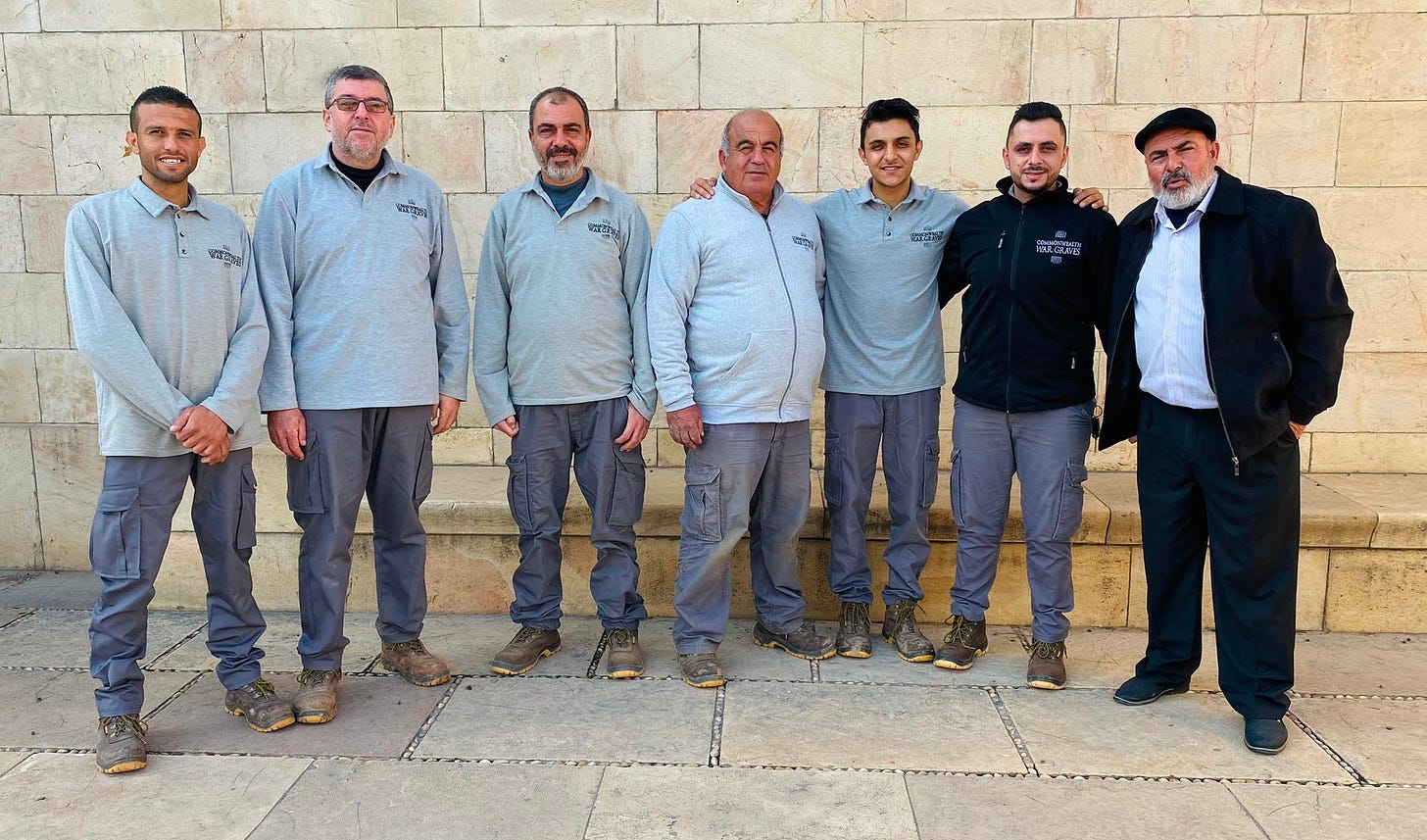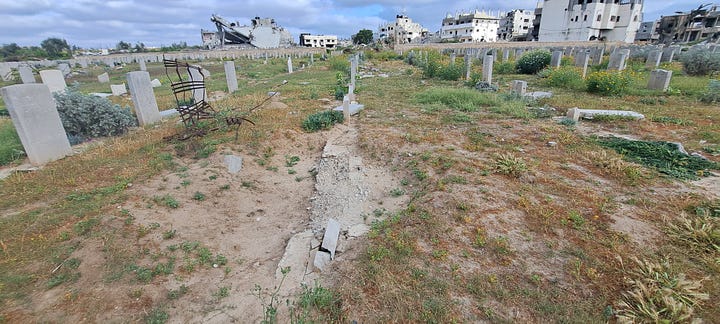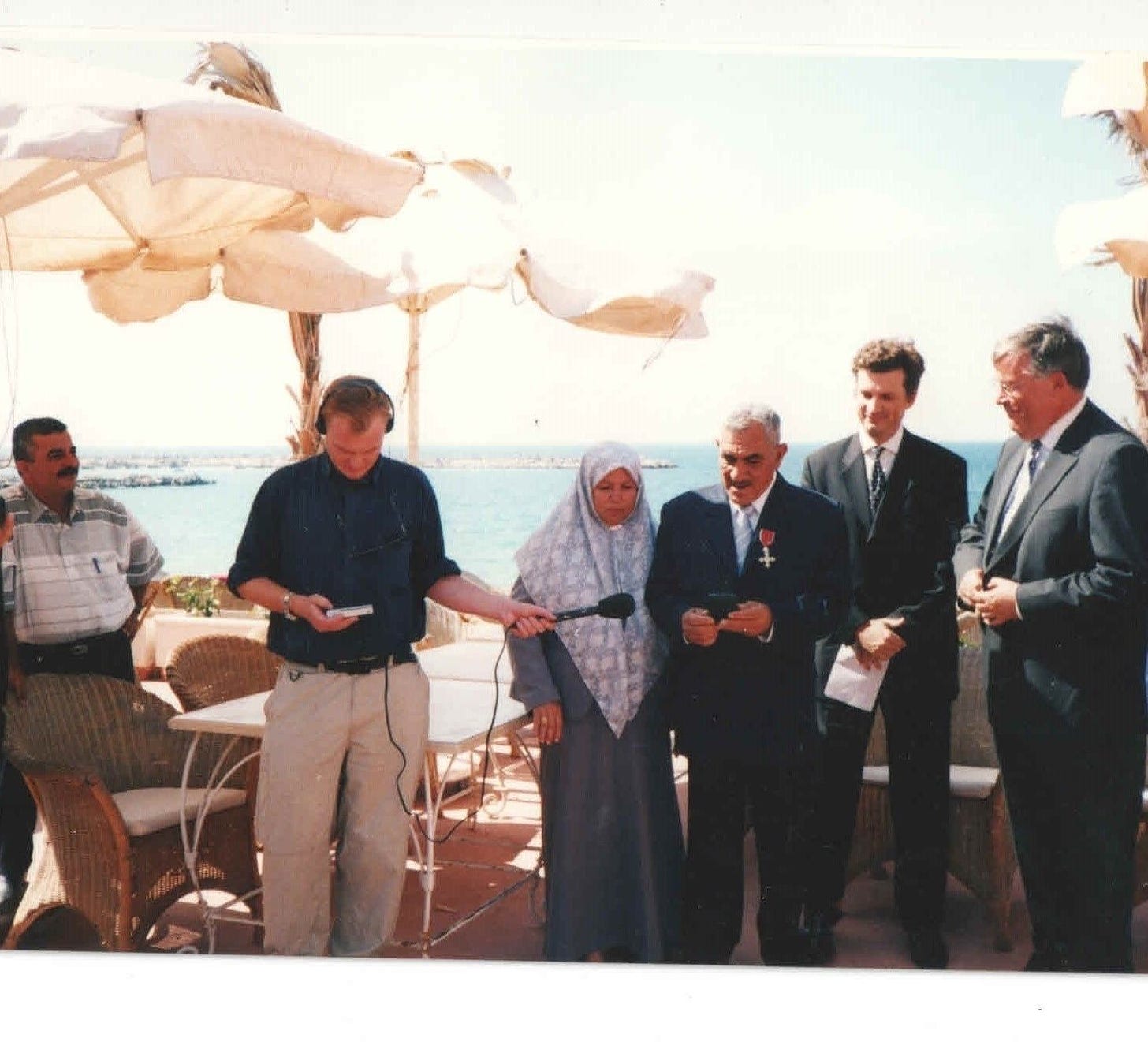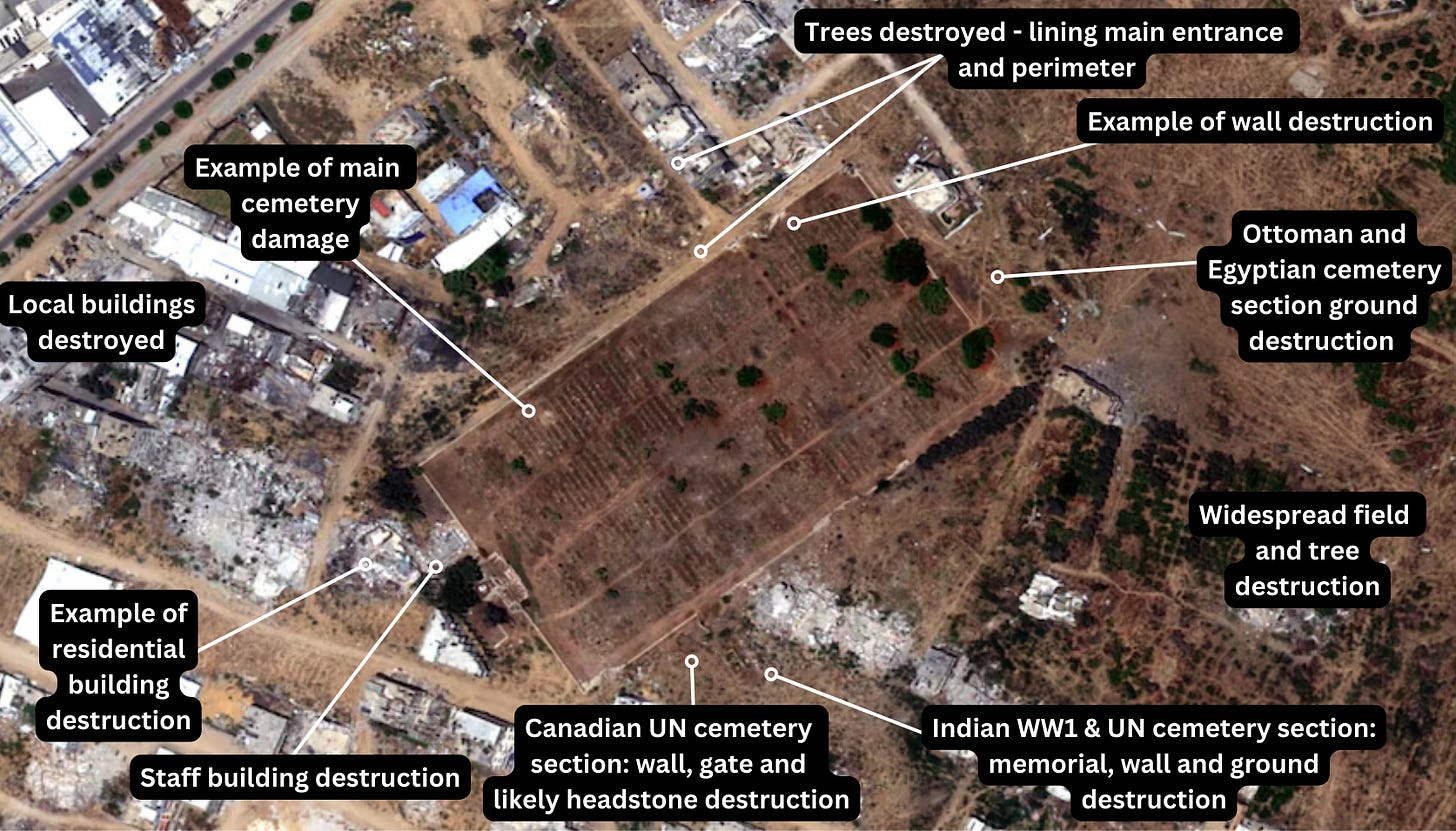Gaza War Cemetery caretakers have fled 'perpetual resting place' and staff house destroyed
Displacement of the Gaza gardeners may mean end to a century-long relationship and lifeline for understanding

Every destroyed home in Occupied Palestine is a threat to the future in the region, but, perhaps, particularly so, the Commonwealth War Graves Commission (CWGC) house at Gaza War Cemetery in Tuffah, Gaza City. Owned by the Commission and a home to the Jaradah family for decades, the house is destroyed and staff displaced with their families. Some have been released into Egypt, others remain. For generations, they, with locals, have been guardians of the memory of Commonwealth war dead and a human connection between Palestine and much of the world, particularly, Britain and the nations that make up its former empire.
The CWGC House is one of the around 163,778 or 66% of structures in the Occupied Gaza Strip to now lie damaged or destroyed. The Gaza War Cemetery itself is damaged, with parts destroyed but still survives - though little else does, with Oxfam warning that northern Gaza is being erased by Israeli forces. Over 42,000 Palestinians have been reportedly killed in Gaza - a figure that is widely considered an under count. 400,000 people are thought to be in northern Gaza, without food, under attack and under forced displacement orders.
The CWGC house was a one floor modest-sized building that stood near the Gaza War Cemetery’s imposing Cross of Sacrifice centre piece and the Record House. It sat outside the large cemetery’s internal perimeter wall, near a residential block of flats and the nearby CWGC office building. From the window was a view of symmetrical rows of over 3,600 headstones, amongst trees, plants and flowers; these commemorate British imperial and Allied war dead of differing faiths from, in particular, three major battles in Gaza with Ottoman forces, in 1917, during the First World War - as well as Ottoman casualties and WW2 and UN peacekeeping dead.
Armchairs on the veranda were used by the Jaradahs to sit with neighbours and guests and converse over tea. With just several steps to a nearby doorway, one would reach the meticulously kept cemetery lawn and its array of trees and plant life. The sound of birds, if not obscured by surveillance drones overhead, accompanied the start of the day’s work. Recent satellite images suggest that, like the majority of structures in the area, the staff house has been destroyed. On-the-ground photos, thought to be from early this year, show that it has been nearly flattened.
Inside the Head Gardener’s small office building next to the CWGC House, likely also destroyed, a number of framed awards were on display on the walls. They recognised the quality, courage and dedication of the work of the staff and came from various sources, including Commonwealth partner states of the Commission. One was from Canada, another, prominently placed, was the MBE awarded by the Queen to the late former Head Gardener, Ibrahim Jaradah (Sr.), who served at the Gaza War Cemetery for over 50 years. The Cemetery signature book testified to the range of visitors - from the descendants of the buried soldiers to journalists and political and military representatives, albeit, dwindling in past decades.
Displacement and damage
There are three major CWGC cemeteries in Gaza; the largest in Tuffah, Gaza City, a second site in Az Zawaida, Deir El-Belah, and a mass burial site for Egyptian Labour Corps men amidst orange groves nearby. The two major war cemeteries have sustained extensive surface level damage in the past year, with significant damage occurring in January 2024, as Israel’s ground invasion expanded. Hundreds of headstones, as well as turf, trees and parts of walls are damaged or destroyed. In the Gaza War Cemetery, the annexes for Ottoman, Indian and Canadian forces appear razed. In the Deir El-Belah War Cemetery, similarly, the outer areas are badly damaged and the Indian section has been razed, seemingly, by heavy vehicles. The state of the Egyptian Labour Corps site is not known.
By contrast to the Gaza War Cemetery, the Palestinian’s Tuffah Cemetery, in the same district, which had a section at least as old as the nearby war cemetery and a new area for victims of the current escalation, has been bulldozed with Palestinian cadavers unearthed and many reportedly removed by Israeli forces early this year.
There is a chance that the Jaradah family graves site in the Eastern Cemetery in east Tuffah is amongst those desecrated in northern Gaza. In January, CNN reported 16 cemeteries desecrated throughout the territory and a systematic practice of destruction, including removal of bodies from a Khan Younis cemetery by Israel for claimed hostage identification purposes. In August, Israeli forces were reported to have returned 89 decomposing Palestinian bodies. No information was given by Israel and it is not known if these remains are bodies removed from cemeteries.
Seven months into the violent escalation, in early May 2024, the Commonwealth War Graves Commission broke its silence on their staff with an online statement revealing that their Gaza team had been released into Egypt with “immediate families” where, with recuperation, their staff would resume work.
The release occurred just as Israel, militarily and politically backed by Western allies, defied more international objections and warnings and invaded the southern city of Rafah, sealing the Rafah crossing. 33 year old Head Gardener, Ibrahim Jaradah, was one of those to have survived and reached safety, with the intervention of the CWGC and the UK government. However, it has since been confirmed by the UK that one member of the team, thought to be Yacoub Ismali, a gardener who is roughly in his fifties, chose to remain behind for family reasons. The fates of retired staff, such as Essam Jaradah and Muhammad Awaja and that of contractors and locals is not clear.

The Jaradah family
Several military cemeteries were created by the British forces that conquered Palestine in 1917/1918, which for the next three decades was ruled by Britain as a League of Nations Mandate. The Imperial War Graves Commission appointed Sir John Burnet as chief architect for Palestine and Gallipoli and a horticultural officer, Robert Kett. They oversaw development of the Gaza War Cemetery which was the second largest in Palestine, after Ramleh War Cemetery. Other sites were built nearby in Deir El-Belah, Beersheba, Haifa and Jerusalem.
According to the CWGC, the Jaradah family’s connection with the War Graves in Palestine goes back 100 years. Rabie Jaradah started work with the Commission in the 1920s, in Beersheba, during the era of British Mandatory Palestine. In 1948, with the eruption in violence of Zionist militias before and during outbreak of regional war, he fled with his family on camel-back, including with his son, Ibrahim Jaradah (Sr.) to Gaza. Some 750,000 Palestinians fled and Israel established itself as a state, conquering extensive Palestinian land. Gaza came under Egyptian control, until the war of 1967, when Israel seized it.
After fleeing to Gaza, Rabie Jaradah was given duties to manage the Imperial War Graves Commission sites at Gaza War Cemetery and in Deir El-Belah. The family were, Ibrahim Jaradah (Jr.) says, given responsibilities with Commission projects in Egypt and Libya too. The Gaza War Cemetery and other sites in the region had been reopened for burials for WW2 casualties. Australian, British and Polish forces, in particular, had training bases and hospitals in Palestine during WW2.
The Gaza War Cemetery was reopened again between 1956-67, after the Suez Crisis, when Israel, France and Britain invaded Egypt. Israel occupied Gaza for several months, until a ceasefire and withdrawal was agreed. UNEF peacekeeping forces were deployed in Gaza and Sinai from 1956 until war broke out in 1967. During this time 22 Canadian and 8 Indian UN forces were buried or memorialised in Gaza War Cemetery.
At this time, Ibrahim Jaradah (Sr.) started working alongside his father, Rabie, at Gaza War Cemetery, as a 20 year old. His son, Essam Jaradah, recalls the Canadian peacekeeping forces as a five years old. "I remember them lowering the boxes into the graves by rope," he told a Canadian journalist, "and then lighting candles. It made an impression I'll never forget.
Ibrahim Jaradah (Sr.) and his family would live through Egyptian rule of Gaza and then, after the 1967 conflict, Israeli occupation. In all, Ibrahim Jaradah (Sr.) served for over 50 years at the Cemetery, continuing caretaker duties and assisting his son and then grandson well after the CWGC’s compulsory retirement age of 65. He died in May 2017, aged 82 years, leaving behind a widow, nine daughters, four sons and many grandchildren. A keen writer, his journals and library of books are amongst the items lost in the rubble at Gaza War Cemetery.

Serving under blockade
In the aftermath of the Oslo Accords, in 1994, Ibrahim Jaradah (Sr.) had been awarded an MBE (Honorary Member of the Order of the British Empire) from the Queen, in recognition for his work with the CWGC. By his own account, given in an interview, Ibrahim Jaradah Sr. chose not to travel to London for the investiture ceremony and instead a ceremony took place at the beach-side Al Deira Hotel in Gaza, presented by British officials from Jerusalem.
Other reports suggest that Ibrahim (Sr.) was barred from travelling. From March 1993, a formalised Israeli ‘security policy’ of ‘closure’ restricted movement and trade beyond the borders of Gaza and the West Bank respectively. At times it was a complete closure. In 2007, after the election of Hamas, the blockade was intensified, with Egypt cooperating.
In a 2012 interview with a visiting British MP, Ibrahim Jaradah (Sr.) recalled a time when Gaza was not under blockade: “I search in my mind what happened, what we can do - before we traveling to Tel-Aviv, to Beer-Sheva, to Asqalan, we working together and eating together and we have a friend. But, now, nobody can find the other. Everybody killed the other and they didn’t know… I don’t like that.”
By his death in 2017, he had lived through half a century of occupation, uprisings and a series of brutal Israeli military assaults. Latterly, he lived through decades of blockade. It was reported that Ibrahim Jaradah spent his final years caring, as well, for his wife after she had a stroke.
From 2007, visits from descendants of the war dead in Gaza War Cemetery dwindled. Access for CWGC staff from outside the territory was severely restricted and the Gaza staff were denied from leaving. However, delegations of politicians and aid workers continued to visit the Commonwealth cemeteries. In May 2000, the Gaza War Cemetery was visited by the Australian Prime Minister, John Howard. This was at the time of the latest peace deal talks managed by the US, which ultimately failed. A new Palestinian uprising against Israeli occupation, the Second Intifada, would erupt later in the year.
Born in the CWGC House
Current Head Gardener, Ibrahim Jaradah (Jr.), now exiled and working in CWGC’s Egypt team, at Alexandria, was born in 1991, amidst the First Intifada, or uprising. This was an outbreak of civil disobedience, strikes, boycotts, protests and violent clashes against Israel’s growing military occupation and brutalisation of Gaza and the West Bank. It lasted from 1987 until 1993, when the Oslo Accords were signed creating the Palestinian Authority (PA) but no real commitment to a Palestinian state.
Ibrahim Jaradah (Jr.) said in an interview that such was the instability at the time, his mother could not safely get to a hospital and instead, gave birth to him in the CWGC house, at the Gaza War Cemetery. He describes himself as a “son of the cemetery” and part of the stones and plants. His father and an uncle were also born on site.
Still a child when the first and only elections took place in Gaza, in 2006, Ibrahim Jaradah (Jr.) has lived most of his life under conflict and the severe blockade, depriving the territory of necessary water, electricity, fuel, medicine, food, building materials and a variety of basic goods. He started working officially for the CWGC in 2012 as an office administrator, supporting his father, Essam. He completed degrees in Agricultural Engineering and Accounting in preparation to follow in the role of Head Gardener and started in October 2019.
Within the CWGC office, successive Head Gardeners communicated with colleagues from across the world, including within Israel - rarely able to travel abroad or receive them in person. Amongst the difficulties was accessing staff training and the receiving of materials such as concrete and headstones to replace those damaged during frequent military assaults. Irrigation and machinery parts have been difficult to access and shortage of petrol at times required staff to modify lawnmowers to run on gas.
From the CWGC office, also, the Head Gardener received requests from descendants of military personnel for photographs of headstones and fulfilled requests for the laying of wreaths. Here the Head Gardener would have liaised with foreign embassies and governmental departments to make arrangements for annual remembrance ceremonies and local schools and universities to organise daily visits and tours.
A history of attacks
The Gaza War Cemetery has survived frequent past Israeli military assaults on Gaza, including in the summer of 2006, after the capture of an Israeli soldier; bulldozers attacked a perimeter wall and, separately, a helicopter fired at a stone monument. Ibrahim Jaradah (Sr.) told the Daily Telegraph that he told his colleagues to leave and remained behind to watch over the site. He said he sheltered indoors for days during the assault, fearful of being struck and took cover under a table. He made calls to colleagues in the CWGC, who contacted the British Embassy in Israel and the bulldozers were called off, leaving a trail of damage. Israel later paid £20,600 in compensation for restoration of the Cemetery.
The Gaza War Cemetery was badly damaged again in the 2008/09 assault known as Operation Cast Lead by Israel, with over 350 headstones damaged and use of white phosphorus reported. Further major bloody assaults on Gaza took place in 2012, 2014, 2018 and 2021. Damage to headstones was reported again in 2014 and during the May 2021 assault. Each time, the staff of Gaza War Cemetery restored the sites, with the support of the Commission. Whilst getting financial settlements and materials from Israel has been arduous - taking months or years, at times, restoration has been possible by the Commission, led by Britain. The same protection and support has not been available for much of the rest of the Occupied Gaza Strip.
The Gaza War Cemeteries have at times been the target of Palestinians groups - in 2004, headstones were vandalised after images were published in British media of torture of detainees at the US-run Abu Ghraib prison in Iraq. It was reported that Ibrahim Jaradah (Sr,) and his son, Essam, chased the men away, some who were armed. In April 2008, the Stone of Remembrance monument was blown up in the Deir El-Belah War Cemetery by a reported Islamist group.
‘A free gift’
Britain’s historic and ongoing role in colonisation and brutal conflict in Palestine - including the ongoing military and political support for Israel from the British Government - has caused some Palestinians to question the legitimacy of the war cemeteries. A sense of injustice that the Cemetery should be restored whilst Gazans have their homes and businesses repeatedly destroyed without compensation or care has also been expressed. However, despite a recent unverified report in The Daily Telegraph of a Hamas plan to use the war dead as leverage against the UK government, the Gaza War Cemeteries have been preserved and valued by the staff and local people for decades.
For the Jaradah family at the Gaza War Cemetery and the Awaja family, who lived on site and took care of the Deir El-Balah War Cemetery, the sites were livelihoods, homes and legacies. Both families arrived in Gaza at different times from Beersheba, now in Israel. Retired Head Gardener, Essam Jaradah has said: “the cemetery has become, over the successive generations, a part of our souls. Since I was young, I have watched my father taking care of the plants and flowers, and today my son watches me, to take on the same task after me.”
Muhammad Awaja, caretaker of some 35 years at the smaller Deir El-Balah War Cemetery in central Gaza told a reporter: “Work starts every day from six-thirty in the morning until three in the afternoon, and my leave is on Thursday and Friday, and here I have everything necessary to work in agriculture and cleaning from the Commonwealth Authority.” Awaja, like the Jaradahs, lived on site at the cemetery, with his family of eight children.
The sites are a major part of the history of conflict during the 20th Century, including, the unfulfilled promise of national self-determination for Palestine. A prominent stone inscription repeated in English, Arabic and Hebrew within the Gaza War Cemetery states: “The land on which this cemetery stands is the free gift of the people of Palestine for the perpetual resting place of those of the Allied armies who fell in the war of 1914-1918 and are honoured here.” This same inscription is also found in the Jerusalem War Cemetery.
The Gaza Cemetery staff hosted daily educational visits for local schoolchildren and students and dialogue with researchers. In the past, it was possible to regularly welcome descendants of the fallen servicemen and women. More recently, staff tended to receive online queries from abroad. They were eager to share the diverse history of the cemetery, which, contrary to common outside perception, hints at the complexity of Gaza, which still has a small Christian population. The Gaza War Cemetery has memorials for Christians, Jews, Hindus, Sikhs and Muslim war casualties.
The Cemeteries also served as a space of natural beauty and open space for local people in Gaza City and the rest of the densely populated territory. The lane leading to the entrance was lined by cypress trees imported from the Netherlands and planted by Ibrahim Jaradah (Sr.). It was described by one visitor as resembling the entrance to a Tuscan villa. Within the limestone walls are a number of jacaranda and Royal Poinciana trees, creating a display of brilliant red when in bloom. The headstones are lined with beds of flowers and herbs. A plant nursery was set up by staff on site to produce seedlings for planting in summer and winter seasons for year-round growth. Trees also lined the perimeter of the cemetery, with tall date palms standing beside the CWGC house.
Gaza City and the entire north, in particular, are under intensified siege and attacks continue on civilians - one year after the first major evacuation order given to local people by Israeli forces. The mass killing and starvation in the sealed off Jabalia refugee camp is occurring close to Tuffah and the Gaza War Cemetery. Workers in Palestinian cemeteries report running out of space for the dead and burying bodies on top of another. Some are being buried by the sides of streets or in other makeshift mass burial sites. Others are left in the open and scavenged upon by animals.
CWGC and the UK government are not commenting on the situation of the CWGC staff member who remains in Gaza, nor the situations of retired staff or contractors. Since last November, there has been almost no media coverage in Britain or elsewhere about the CWGC staff or damage sustained to the Gaza war cemeteries.
Recent satellite images and photos shared by Gazans from early in the year suggest that the War Cemeteries have so far been spared the widespread excavation and destruction inflicted on so many Palestinian cemeteries. There is a report that the sites are being protected by Israeli forces and access being barred. Settler groups, meanwhile, in Israel are eyeing the sites as part of colonisation plans.
A British historian reports that when he asked the late Ibrahim Jaradah (Sr.) why he has dedicated his life to work at the War Cemeteries, he said: “It is important to respect all dead people, whatever their nationalities. If the people in Gaza didn’t respect or accept the cemetery, you wouldn’t see it like this.”
Every day it is harder to see a decent future for Gaza, let alone the War Cemeteries and other historic sites. Relationships of connection and mutual understanding are being destroyed. It is long overdue for Britain to cease its participation in the genocidal assault.




Images of Gaza War Cemetery in early 2024, the precise date is unknown.(K.Ramlawi/2024)
Satellite image of Gaza War Cemetery showing damage, July 2024 (Courtesy of ABC News/SkyWatch)
Screenshot showing the CWGC Staff House in 2018. The image is from a short documentary, ‘The English Cemetery of Gaza - A Strange Neighbour’ by Ain Media. It is available to watch on Youtube here.
Update
In November 2024, the Australian government released a CWGC October Gaza War Cemeteries status report. It contains an assessment of estimated damage, including to headstones, burials and infrastructure. It also confirms details about the situation of staff. Read more:







